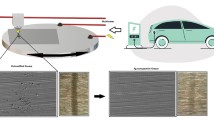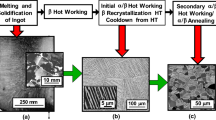Abstract
Measurements of crack growth at fatigue frequencies of 100, 1 and 1/60 Hz in some gaseous environments show that changes of crack rate with frequency can be partly or entirely due to environment, depending on the alloy. The effects of oxygen, water vapor alone and water vapor in the presence of oxygen and nitrogen have been studied. The critical gas pressures which are necessary to affect crack growth depend on frequency and crack rate. Mechanisms for the effects observed are discussed and results are interpreted in terms of gas adsorption at the crack tip and the immediate action of adsorbed surface layers on the crack while it is growing.
Zusammenfassung
Bei Ermüdungsfrequenzen von 100, 1 und 1/60 Hz zeigen Messungen des Rißwachstums daß für eine gewisse Legierung die Veränderung des Wachstums als Funktion der Frequenze teilweise oder völlig von der Umgebung abhängt. Man hat versucht den Einfluß von Sauerstoff, Wasserdampf und Wasserdampf im Gegenwart von Sauerstoff und Stickstoff zu untersuchen. Der notwendigerweise das Rißwachstum zu verändemde kritische Gasdruck hängt von Frequenz und Fortpflanzungsgeschwindigkeit ab. Die Vorgänge bei den beobachten Erfolgen werden erörtert. Die Ergebnisse deuten auf Gasadsorption an den Rißenspitzen and auf die unmittelbare Wirkung der Flächenschichten auf den wachsenden Riß.
Résumé
La mesure de la croissance de fissure aux fréquences de fatigue de 100, 1 et 1/60 Hz dans des environments gazeuses montre pour un alliage défini que la variation de la vitesse de croissance avec la fréquence depend de ]'environment soit partiellement, soit totalement. L'effet d'oxygène, vapeur d'eau, et vapeur d'eau en présence d'oxygène et azote a été à l'étude. La pression critique de gaz à que la croissance vient de changer dépend de la fréquence et de la vitesse de propagation. Les mécanismes pour les effets observés sont discutés et les résultats s'attribuent à l'adsorption de gaz à l'extrémité de fissure et à l'action immédiate des couches superficielles sur la fissure croissante.
Similar content being viewed by others
References
A. Hartman, Intl. J. Frac. Mech., 1 (1965) 167.
C. Wheeler, Appl. Mat. Res., 5 (1966) 112.
A. Hartman, F. A. Jacobs, A. Nederveen and P. de Rijk, NLR-TN M.2182, 1967.
R. P. Wei, Intl. J. Frac. Mech., 4 (1968) 159.
M. J. Hordon and M. A. Wright, Trans. Met. Soc. A.I.M.E., 242 (1968) 2011.
W. T. Schijve Adv. Aero. Sci., 3 (1962) 387.
W. T. Koiter, Report No. 314 Dept. Mech. Eng., Technological University, Delft, The Netherlands.
D. P. Rooke, RAE Tech. Report 67238, September 1967.
A. J. Kennedy, Processes of Creep and Fatigue in Metals. Oliver and Boyd, Edinburgh, U.K., (1962) 301.
F. J. Bradshaw, Scripta Met., 1 (1967) 41.
E. E. Huber and C. T. Kirk, Surface Science, 5 (1966) 447.
C. T. Kirk and E. E. Huber, Surface Science, 9 (1968) 217.
F. Jona, J. Phys. Chem. Solids, 28 (1967) 2155.
M. R. Achter, Scripta Met., 2 (1968) 525.
C. Laird, Fatigue Crack Propagation, ASTM STP415, 1966.
D. A. Meyn, Trans. A.S.M., 61 (1968) 52.
P. J. E. Forsyth, Proceedings, Crack Propagation Symposium, Cranfield 1961.
Author information
Authors and Affiliations
Additional information
Crown copyright, reproduced with the permission of the Controller, Her Majesty's Stationary Office.
Rights and permissions
About this article
Cite this article
Bradshaw, F.J., Wheeler, C. The influence of gaseous environment and fatigue frequency on the growth of fatigue cracks in some aluminum alloys. Int J Fract 5, 255–268 (1969). https://doi.org/10.1007/BF00190956
Received:
Revised:
Issue Date:
DOI: https://doi.org/10.1007/BF00190956




